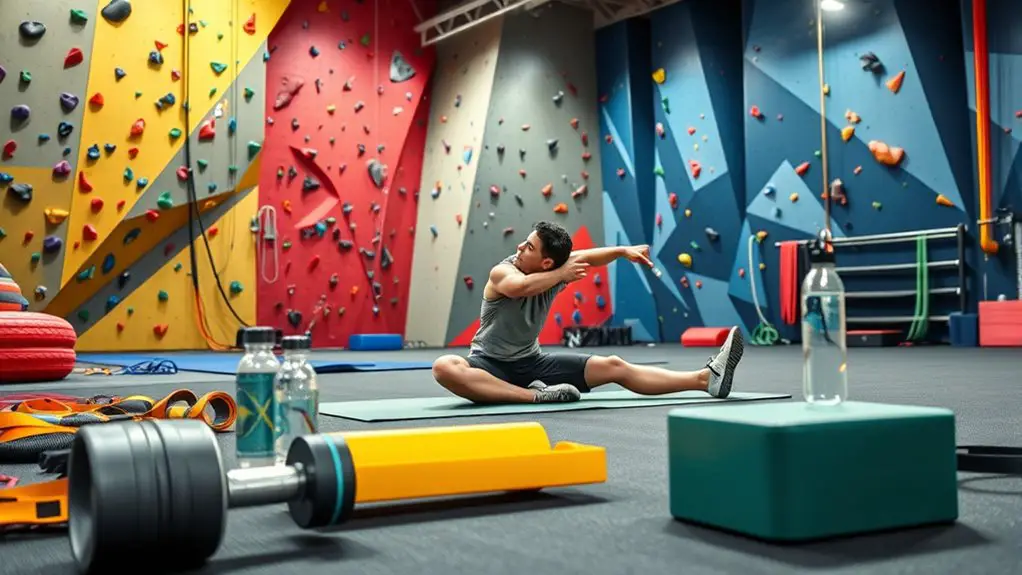The Best Gym Workouts for Climbers and Mountaineers

To excel in climbing and mountaineering, focus on core strength, grip strength, leg power, cardio endurance, and flexibility. Incorporate planks and stability exercises for core stability. Strengthen your grip with hang boards and pinch holds. Boost leg power through squats and deadlifts, while enhancing endurance with interval training and outdoor cardio. Don’t forget to stretch for flexibility and prevent injuries. Embrace a solid recovery routine, and you’ll see massive gains in your climbing performance. There’s so much more to explore!
Building Core Strength for Stability and Balance

When you’re scaling a rock face or traversing a steep trail, having a strong core isn’t just beneficial—it’s crucial. Core stability plays a crucial role in your climbing performance, allowing you to maintain control and balance, especially on challenging routes. By incorporating balance training into your workouts, you can enhance your core strength and improve your overall stability.
Exercises like planks, Russian twists, and stability ball workouts target your core muscles effectively. Adding balance training elements, such as single-leg exercises and stability board drills, challenges your body to engage the core more dynamically. This not only strengthens your midsection but also improves your proprioception, helping you feel more secure on your feet.
Enhancing Grip Strength for Better Climbing Performance
To take your climbing game to the next level, enhancing your grip strength is essential. Stronger grip not only improves your performance but also helps prevent injuries. Let’s explore some effective grip exercises that can make a real difference in your climbing journey.
Effective Grip Exercises
Many climbers overlook the importance of grip strength, yet it plays a crucial role in your overall climbing performance. To boost your grip, consider incorporating these effective exercises into your routine:
- Hang boards: Use these to build finger strength; start with 10 seconds on and 50 seconds off.
- Pinch holds: Grab weighted pinch grips to enhance your thumb and finger strength.
- Farmer’s walks: Carry heavy weights in each hand to improve endurance and grip stability.
- Dead hangs: Hang from a bar for time, focusing on engaging your fingers and forearms.
Importance of Grip Strength
Grip strength is a game-changer for climbers and mountaineers, influencing not just your ability to hold onto various surfaces but also your overall endurance and performance on the rock. By enhancing your grip strength through targeted exercises, you can tackle challenging routes with confidence. Incorporating different grip variations using specialized grip tools can greatly boost your training.
| Grip Variation | Recommended Tool |
|---|---|
| Crimp Grip | Hangboard |
| Open-Hand Grip | Fingerboard |
| Pinch Grip | Pinch block |
Focusing on these variations helps build strength in your fingers and forearms. So, grab those tools and start working on your grip—you’ll notice a remarkable difference in your climbing performance!
Developing Leg Power for Ascents and Descents

While tackling steep trails and rocky descents, developing leg power is vital for climbers and mountaineers. Strong legs will enhance your performance, allowing you to ascend more efficiently and descend with confidence. To build that power, incorporate these exercises into your gym routine:
- Leg Press: This exercise targets your quads, hamstrings, and glutes, giving you explosive strength for those challenging climbs.
- Squat Variations: Whether it’s back squats, front squats, or single-leg variations, squats are fantastic for building overall leg strength and stability.
- Lunges: These help with balance and coordination while mimicking the movements you’ll encounter on the trail.
- Deadlifts: Strengthening your posterior chain is essential for both powering up inclines and stabilizing during descents.
Improving Cardio Endurance for Long Treks
To tackle those long treks, boosting your cardio endurance is key. Incorporating interval training techniques and steady-state cardio can transform your stamina, while mixing in outdoor activities keeps things fresh and exciting. Additionally, incorporating jump rope exercises can provide an excellent cardiovascular workout to further enhance your endurance and agility. Let’s explore how to elevate your endurance and make every journey feel like an adventure!
Interval Training Techniques
If you’re looking to boost your cardio endurance for those long treks, interval training can be a game-changer. This method alternates between high intensity and recovery periods, maximizing your stamina and efficiency. Here are some effective techniques to include in your routine:
- Sprint Intervals: Alternate between short bursts of sprinting and slower-paced recovery.
- Hill Repeats: Tackle inclines at high intensity, then walk or jog back down.
- Circuit Training: Combine various exercises in quick succession, focusing on both strength and cardio.
- Tabata Protocol: Engage in 20 seconds of all-out effort followed by 10 seconds of rest for 4 minutes.
Incorporate precise interval timing, and you’ll see significant improvements in your endurance for those epic climbs!
Steady-State Cardio Benefits
Steady-state cardio is a vital component for climbers and mountaineers aiming to improve their endurance on long treks. By maintaining a consistent pace, you’ll enhance your cardiovascular efficiency, allowing you to tackle those extended climbs with greater ease. The steady state benefits include increased stamina, improved oxygen utilization, and better fat metabolism, all essential for high-altitude adventures.
| Benefit | Description | Impact on Climbing |
|---|---|---|
| Increased Stamina | Longer workout sessions at a steady pace | Reduces fatigue on long treks |
| Improved Oxygen Utilization | Enhances your body’s ability to use oxygen | Boosts performance at altitude |
| Better Fat Metabolism | Utilizes fat as a primary energy source | Sustains energy during climbs |
| Enhanced Recovery | Promotes quicker recovery post-trek | Prepares you for subsequent climbs |
Outdoor Activity Integration
Integrating outdoor activities into your training regimen can greatly boost your cardio endurance for long treks. Not only will you enhance your physical capabilities, but you’ll also sharpen your outdoor skills and nature awareness. Here are some effective activities to contemplate:
- Hiking: Choose varied terrains to challenge your stamina.
- Trail Running: Boost your speed and endurance while enjoying the scenery.
- Cycling: Explore local trails to build leg strength and cardiovascular fitness.
- Kayaking: Engage your core and upper body while steering waterways.
Increasing Flexibility to Prevent Injuries
While climbing and mountaineering demand strength and endurance, increasing flexibility is equally essential for preventing injuries. By incorporating practices like dynamic stretching and yoga into your routine, you can enhance your range of motion and reduce the risk of strains.
Here’s a quick overview of how to improve flexibility:
| Method | Benefits |
|---|---|
| Dynamic Stretching | Prepares muscles for activity |
| Yoga | Improves balance and posture |
| Targeted Stretches | Focuses on specific muscle groups |
Engaging in dynamic stretching before your climbs helps warm up your muscles. Meanwhile, regular yoga sessions not only deliver yoga benefits like improved flexibility but also promote mental clarity. So, integrate these techniques into your training—your body will thank you, and you’ll climb with greater confidence and reduced injury risk!
Crafting a Comprehensive Recovery Routine

After intense climbing sessions, it’s essential to prioritize recovery to guarantee your body bounces back and stays strong. A thorough recovery routine helps you prevent injuries and enhances your performance. Here are some effective recovery techniques and nutrition strategies to reflect on:
Prioritizing recovery after climbing is crucial for injury prevention and performance enhancement.
- Hydrate: Drink plenty of water post-workout to replenish lost fluids.
- Stretch: Incorporate dynamic stretching to improve flexibility and reduce muscle tightness.
- Refuel: Consume a balanced meal rich in proteins and carbohydrates within 30 minutes of finishing your climb.
- Rest: Prioritize sleep to allow your muscles to repair and grow stronger. Additionally, be mindful of lower back pain that may arise from certain activities, as proper recovery techniques can help alleviate discomfort.
Frequently Asked Questions
How Often Should I Train Each Muscle Group for Climbing?
You should aim to train each muscle group at least twice a week for peak performance, but don’t forget about muscle recovery! Balancing training frequency is key; allow at least 48 hours between working the same muscles to promote healing and growth. Listen to your body—if you’re feeling fatigued, it’s okay to rest more. Consistency, combined with proper recovery, will help you build strength and stamina effectively. Keep pushing yourself!
What Nutrition Is Best to Support Climbing Workouts?
To support your climbing workouts, focus on proper nutrition. Carbohydrate timing is essential; consume complex carbs before your training to fuel your muscles. After your session, prioritize protein sources like lean meats, legumes, or protein shakes to aid recovery and muscle repair. Don’t forget to hydrate! Eating a balanced diet will keep your energy levels high and help you climb stronger. Remember, fueling your body right is just as important as your workouts!
Should I Focus on Strength or Endurance First?
When deciding whether to focus on strength or endurance first, consider your goals. If you’re aiming for explosive power, start with strength training; it’ll build a solid foundation. However, if you’re looking to sustain longer climbs, prioritize endurance training. Ultimately, a balanced approach is key—mixing both will enhance your performance. Don’t forget to listen to your body, as it’ll guide you in finding the right balance between strength and endurance for your needs.
How Can I Track My Progress Effectively?
Did you know that setting specific goals can increase your likelihood of success by up to 42%? To track your progress effectively, start by establishing clear, measurable goals. Use a journal or an app to record your workouts, noting weights, reps, and how you feel. Regularly reviewing this data not only keeps you motivated but also helps you adjust your training plan. Stay committed, and you’ll see your progress unfold!
What Are Common Mistakes to Avoid During Training?
When training, it’s easy to make mistakes that can hinder your progress. One common issue is ignoring overtraining symptoms, like fatigue and decreased performance. If you notice these signs, it’s essential to implement effective recovery techniques, such as rest days and proper nutrition. You’re building strength, but don’t forget that recovery is just as important. Stay mindful of your body’s signals, and you’ll avoid burnout while maximizing your training potential.





